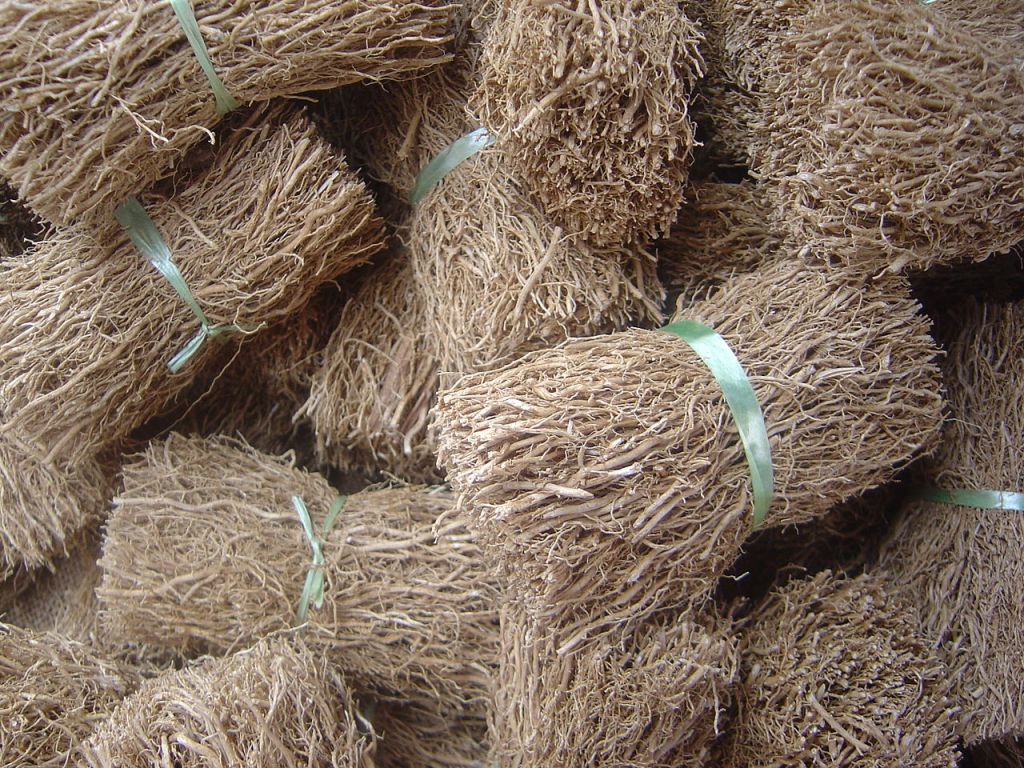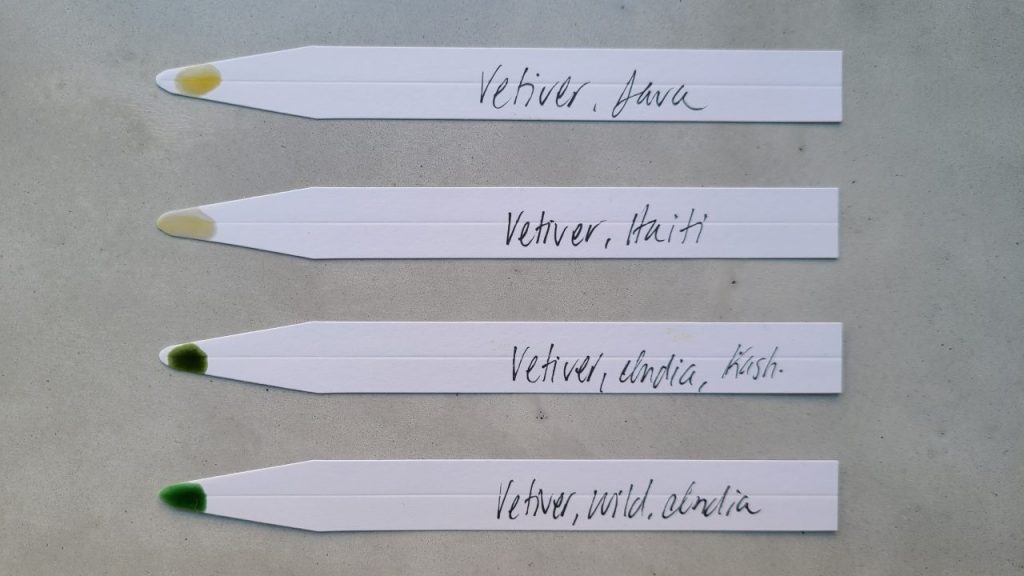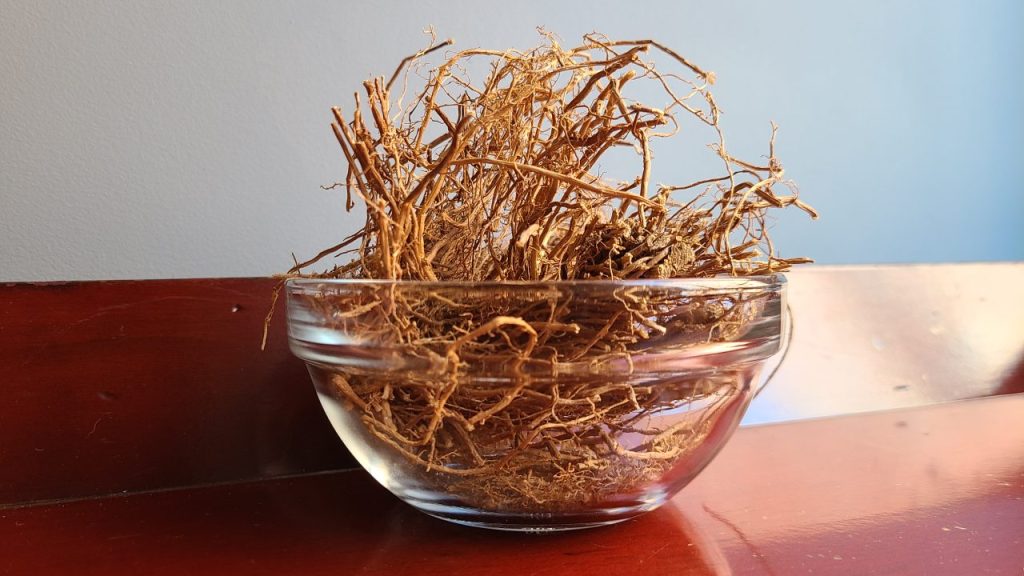Your cart is currently empty!
What comes to mind when you hear the word “grass”? Verdant blades and swaths of green lawn or dried, fragrant roots that run deep? Welcome to Vetiver’s magical world and the grounding essential oil distilled from its aromatic roots! Scroll down to learn more about Vetiver’s personality, therapeutic applications, blending notes and incorporating Vetiver into aromatherapy products.

What is Vetiver?
Vetiver is a perennial clumping grass classified in the Poaceae family, whose leaves may grow up to 150 cm. When allowed to flourish, the roots may grow up to 4 meters. The root configuration is finely structured and dense, culminating in thick mats that give Vetiver remarkable drought tolerance and stability. This intricate root mass bestows Vetiver the superpower to stabilize and protect land from soil erosion. Furthermore, the plant is a heavy-duty phytoremediation agent for soil reclamation as it processes nitrates, phosphates and heavy metals. Vetiver creates its root-bound essence in humid to sub-humid tropical environments, such as India and Sri Lanka, where it prefers to spread its roots in well-drained sandy soil but is widely adapted to most ecological environments, from wetlands and riverbanks to plains and sandy coasts.
Vetiver’s Cool, Calm and Collected Nature
Although Vetiver essential oil is heavily used in the cosmetics, aromatherapy and flavor and fragrance industries it behooves us to reflect upon Vetiver’s valued place in human culture since antiquity. One often cited example is how Vetiver’s cooling roots have been used in India to make screens, mats, hand fans and baskets. The screens, hung like curtains through living quarters in hot weather, are sprinkled with water and a perfumed cooling effect is realized through the living space (Rao R.R., 2000). This cooling quality is only one of its many virtues. The plant is an effective insect repellent for home and agricultural use. It is still used as medicine against poisons, stings and bites. Infusions are made of the root to cool fevers, relieve digestive issues and urinary infections. Topical applications (e.g., root paste) are made to soothe burns and relive aches and pains (Burger P, 2017). The aforementioned medicinal uses are just a glimpse of the plant’s many virtues and there is a plethora of research on this beautiful ally!
Vetiver’s Many Names
Let’s get into names. We have the Tamil language to thank for the word “vetiver” as it references how the grass’s roots are collected and processed: “vetiver” means “hatcheted up” (Mojay, 1997) and is from the word “vetivern” (C. K. Atal, 1982). Vetiver goes by several names in the Latin binomial system: Vetiveria zizanioides (L.) Nash (synonym: Andropogon muricatus Retzius, Andropogon zizanoides Urban and Chrysopogon zizanioides Roberty). It also goes by an array of common names depending on the referential culture and geography: Khus-khus and Khus (indicating plants grown in India), Khas-khas, Akar wangi, Larasetu, Nara wastu and Kusu kusu among others (Holmes, 2016). To be even more nuanced, wild harvested Vetiver from India is called Ruh Khus. The general consensus is the “highest quality” essential oil is obtained from plants grown in the Reunion Islands and India (preferably Ruh Khus in my opinion); though interestingly the plant is not native to the Reunion Islands and was brought there in the 18th century.
Impressions of Vetiver Essential Oil

Obtaining Vetiver Essential Oil
Vetiver essential oil is distilled from the washed, dried and chopped roots, rhizomes and rootlets of the tropical grass that goes by the Latin moniker of Vetiveria zizanioides. Notable take-away: Chrysopogon zizanioides Roberty is the recently preferred Latin binomial, though I still use the former. Although native to India, the grass is mainly grown and distilled for its thick and complex essential oil in Java, Sri Lanka, the Reunion Islands, Haiti and (of course) India. The distilled roots yield 1 kg (average) of oil for every 50 kg of prepared roots (Holmes, 2016). Distillation time may take upwards of 12 or more hours with 10-12 being optimal according to K. K. Aggarwal.
Overall Personality of Vetiver Essential Oil
Just as Vetiver’s roots stabilize and restore the Earth, it may also be our ally for holding ground by offering us a firm mat to partake in restorative practices. Its oil is quieting and creates a supportive space to give voice to the grounding and yin-feminine energy in all of us. It communicates Earth-wisdom that may assist in condensing and manifesting scattered thoughts into tangible reality. Vetiver helps bring us back to the Earth, back to our body, reminding us of where we really are–here–and what we are made of.
This is an invitation: release yourself from a scattered-tense, racing mind and sink into the calming, Earthly presence of Vetiver.
Physical Impressions of Vetiver Essential Oil
Oh, Vetiver. You had me at hello. You find tension, swirl around it, hold it then let it immediately melt away without my feeling a thing. Within seconds, through olfaction, pulsing is brought to held tension, followed by a heady, weighted sensation in mind-body from your dense-dispersive-penetrating aromas. You are unfailing in your propensity to cool mind and body at once. I have shared Vetiver during countless presentations and classes and reliably have the same immediate cooling of my body (even during a hot NYC summer) and emotions (hyper-vigilance and nervousness from public speaking), everything slows and quiets down from speech to thoughts. Ease and density are felt. Vetiver’s activity is diffuse and pervasive, sinking into everywhere, releasing tight heat, bringing an open solidness and weighted-ness in the body—the human who is up in the clouds, in the head, in the ivory tower is gently brought back down to Earth.
Vetiver influences circulation, gentle pulsing through the body without a direct target: overall tension is released throughout, gently; hyper qualities are dispersed. Breathing is quickly brought to parasympathetic resonance; Vetiver is in no rush and brings you to the same speed. Think of how Vetiver essential oil is thick, sticky, viscous, as slow as molasses. These qualities are mirrored in its ability to promote a slow, gentle receptivity and openness in our mind-body that is similar, but quite different, from Patchouli.
Vetiver lets you know you are safe, embodied, held. You can rest now; Vetiver holds a cooling dispersive space for you. You glide along, feeling light but weighted, knowing there is no rush. Funny what comes to mind: a cooling, weighted blanket. You are at peace and can let go.
What does Vetiver Essential Oil Smell Like?
Note: the following description is of Ruh Khus which has a slightly “softer” profile than a Vetiver from Haiti and even more so than an oil from Java.
Imagine a thick, viscous drop of vetiver essential oil sitting round and fat on a scent strip. As it slowly seeps into the paper a sweet, earthy, woody and deep aroma permeates the air. Subtle notions of soft, wet earth are present with a warm, smoky hint that turns into cool and musty notes, bringing to mind an old and noble library in a comfortably cool stone house on a warm day. Vetiver brings forth rich and sumptuous images of lush textiles, carpets and leather. Although the aromas are deep and penetrating, the encounter is soft rather than direct or abrupt. There is a faint touch of ozone and sea air as if a gentle rain passed on an early summer day where the soil is left cool, damp and smelling slightly sweet and floral. The Vetiver experience is like listening to Erik Satie’s music while gazing at a Whistler “nocturne” painting.

Blending with Vetiver Essential Oil
Consider blending the following essential oils with Vetiver for therapeutic reasons based on your intention and aesthetic compatibility (e.g., perfumery): Myrrh (Commiphora molmol), Lavender (Lavandula angustifolia), Patchouli (Pogostemon cablin), Grapefruit (Citrus x paradisi), Black spruce (Picea mariana), Lemon (Citrus limon), Ginger (Zingiber officinale), Neroli (Citrus aurantium var amara), Cypress (Cupressus sempervirens), Sweet orange (Citrus sinensis), Sandalwood (Santalum album), Palmarosa (Cymbopogon martinii), Jasmine (Jasminum officinale), Frankincense (Boswellia carterii), Lemongrass (Cymbopogon citratus) and Rose (Rosa damascena).

Vetiver Essential Oil Affinities and Usage Applications
Key therapeutic indications for Vetiver essential oil present as weak, tense, hot conditions. Vetiver is an overall cooling, fortifying and nurturing oil. Turn to Vetiver for the following indications:
- Psychological/Emotions/Nervous: relaxing, sedating, grounding, soothing anxiety and feelings of being overwhelmed, mild depression, burn-out, agitation, anger with red heat, hypersensitivity, insecurity, overstimulated, hypervigilance.
- Circulatory: tonifying (vasculature, capillaries), enhancing circulation.
- Immunity: a prophylactic for general immune support, anti-fungal.
- Musculoskeletal: muscular tension, aches and pains, stress-related tension, arthritis, fortifying connective tissue (see skin as well).
- Reproductive: menopause (e.g., hot flashes), PMS, postnatal depression, reduced sex drive (performance anxiety).
- Skin: regenerative, inflammation, acne, eczema, itchy/scratchy skin, weak/lose/lax tissues (e.g., stretch marks, wrinkles), fungal infections.
Notes on Vetiver Essential Oil Chemistry and Safety
Vetiver essential oil is complex with over 150 identified components; that’s not to say there are not more, including poetic trace components that humans and their analytical devices have yet to categorize. It is notably rich in myriad sesquiterpenes and sesquiterpene alcohols supported by ketones which greatly contribute to its special aroma (K.J. Thara Saraswathi, 2011). Vetiver is shown to be non-toxic and non-irritating. Though essential oils from plants grown in certain geographies my contain isoeugenol, a known fragrance allergen.
Making Aromatherapy Products with Vetiver Essential Oil
Supportive Toning Oil for Face and Body
Treat your skin with a blend of ancient essential and nut & seed oils! This blend is indicated for dry, inflamed skin that would also benefit from astringent qualities. Remember, the base (fixed) oils are just as important as the essential oils: learn more about base oils here. Following is what you need:
- 1 ounce glass bottle with dispenser top of your preference
- 1 ounce of a nut/seed oil blend appropriate for your skin type
- 2 drops Vetiveria zizanioides
- 2 drops Rose (Rosa damascena)
- 8 drops Myrrh (Commiphora molmol)
How to use: Consider following this routine 3 to 5 times a week (1x/day) depending on your skins tolerance for the fixed oils of your choice.
- Cleanse your skin as you normally would.
- Immediately follow cleansing with a toner made of Rose (Rosa damascena) hydrosol.
- Dispense 1 to 3 drops of the face oil to your clean fingertips and massage into your skin (adjust to more or less drops to suit your needs).
A Classic Sleep Mist with Vetiver Essential Oil
One of the most versatile ways to incorporate essential oils into your life is through spritzers! Deepen your learning about aromatherapy sprays through this immersive class about spritzers!
What you need:
- 2 ounce glass bottle with spray top
- 2 ounces of distilled water
- Choose 1 of the below blends to add to the spray bottle:
- This is a classic calming, sedative blend of essential oils that is great for all ages.
- 4 drops Vetiveria zizanioides
- 5 drops Roman chamomile (Chamaemelum nobile)
- 20 to 25 drops Lavender (Lavandula angustifolia)
- This is less of a sedative blend and more of a mood-modulating and relaxing blend.
- 2 drops Vetiveria zizanioides
- 4 drops Clary sage (Salvia sclarea)
- 4 drops Rose geranium (Pelargonium graveolens)
- 5 drops Ylang ylang (Cananga odorata Complete)
- 15 drops Lavender (Lavandula angustifolia)
How to use: Shake before each use. Spray your bedding 2 to 3 times as you are preparing for sleep. Use nightly, at least 5 to 7 nights, to enjoy the spray’s effects. Avoid eyes and other mucus membranes should you like to enjoy this as a body or face mist.
Getting Grassy: Musculoskeletal Wellbeing Blend
This blend cheekily incorporates 3 of the grasses of aromatherapy (!) to offer a beautifully smelling and effective topical application for taking the edge-off of aches and pains.
- 5 drops Lemongrass (Cymbopogon citratus)
- 8 drops Vetiveria zizanioides
- 10 drops Black pepper (Piper nigrum)
- 16 drops Palmarosa (Cymbopogon martinii)
- 20 drops Spike lavender (Lavandula spicata)
How to make: add the essential oils listed above to a 2-ounce glass bottle with a dispenser top of your choice. Swirl around to mix. Add 1 ounce of a penetrating fixed oil (e.g., sesame, hemp, tamanu) and 1 ounce of an herbal infused oil (e.g., Arnica montana infused sunflower oil) to the bottle. Affix the cap and label the bottle.
How to use: apply to sore spots as needed.
On a parting note: have you tried drinking Vetiver root tea? Or Vetiver root and Rose petal tea? Oh my, those teas are divinely calming and fragrant. Learn how to make gorgeous teas (aka water infusions) in my “Teas, Tisanes and Water Infusions” class! Learn about herbal infused oils and how to make your own in this quick but informative DIY class.
Thank you for spending time with Vetiveria zizanioides and me.
Learn the Art of Making Herbal Teas and Infused Oils!
How to Make Herbal Teas, Tisanes and Water Infusions
Herbal medicine is for everybody, and in this fascinating course, Amy brings you into the world of herbal teas, tisanes, and water infusions. Through vivid and informative graphics and a beautifully shot video-based class, you will learn how different herbs affect your systems and organs, and how an Enjoyable Beverage…
How to Make Herbal Infused Oils
Are you interested in making your own herbal infused oils to incorporate into topical aromatherapy and herbal preparations such as body oils, salves, and creams? This captivating and insightful step-by-step class shares recipe ideas, tips, and the “how to and why” for creating fabulous herbal oils. This is an opportunity…
Citations and Resources
Burger P, L. A. (2017). Vetiver Essential Oil in Cosmetics: What Is New? Medicines (Basel), 4, 41. doi:10.3390/medicines4020041
C. K. Atal, B. M. (1982). Cultivation and Utilization of Aromatic Plants. Regional Research Laboratory, Council of Scientific & Industrial Research.
Holmes, P. (2016). Aromatica A Clinical Guide to Essential Oil Therapeutics. London: Singing Dragon.
K.J. Thara Saraswathi, N. J. (2011). Comparitive Study on Essential Oil in Natural and In vitro Regenerated Plants of Vetiveria zizanioides (Linn.) Nash. American-Eurasian J. Agric. & Environ. Sci., 458-463.
K. K. Aggarwal , Aparbal Singh , A. P. Kahol & Man Singh (1998) Parameters of Vetiver Oil Distillation, Journal of Herbs, Spices & Medicinal Plants, 6:2, 55-61, DOI: 10.1300/J044v06n02_07
Mojay, G. (1997). Aromatherapy for Healing the Spirit: Restoring Emotional and Mental Balance with Essential Oils. Rochester: Healing Arts Press.
Rao R.R., S. M. (2000). Vetiveria zizanioides (Linn.) Nash–a multipurpose eco-friendly grass of India. Proceedings of the 3rd International Vetiver Conference, (pp. 439-442). Thailand.
Tisserand R, Y. R. (2014). Essential Oil Safety Second Edition. Edinburgh: Elsevier.





Leave a Reply